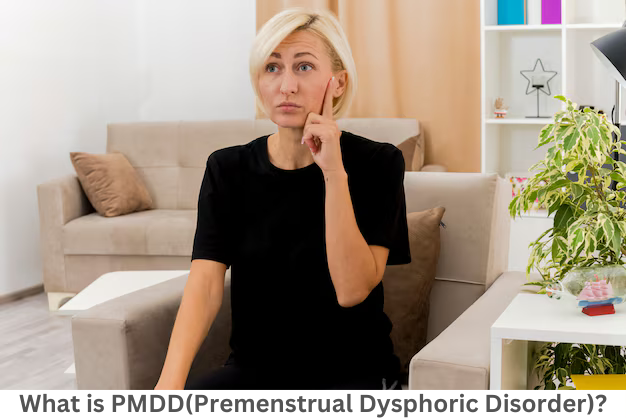What is PMDD(Premenstrual Dysphoric Disorder)?
For many women, the week or two leading up to their period can be a rollercoaster of emotions. Bloating, cramps, and mood swings are all par for the course during Premenstrual Syndrome (PMS). But for some, these symptoms reach a level that significantly disrupts daily life. This is Premenstrual Dysphoric Disorder (PMDD), and it's a condition that deserves understanding and support.
PMDD is a severe form of PMS characterized by intense emotional and physical symptoms that occur in a predictable pattern throughout the menstrual cycle. These symptoms typically appear in the luteal phase (the week or two leading up to your period) and disappear within a few days after menstruation begins.
Common PMDD Symptoms:
Emotional: Irritability, anger, anxiety, depression, mood swings, difficulty concentrating, feeling overwhelmed, social withdrawal, tearfulness, and increased conflict in relationships.
Physical: Bloating, breast tenderness, fatigue, headache, muscle aches and pains, sleep problems, and changes in appetite.
Differentiation from PMS: The key difference between PMS and PMDD is the severity of symptoms. While PMS symptoms may be bothersome, they rarely interfere with daily life. PMDD symptoms, on the other hand, can be debilitating and significantly impact your work, relationships, and overall well-being.
Symptoms of PMDD
PMDD symptoms usually start one to two weeks before menstruation and typically resolve shortly after the period begins. Key symptoms include:
Mood Swings: Irritability, sudden sadness, or episodes of crying are common.
Anxiety: Increased feelings of nervousness, worry, or restlessness.
Depression: Feelings of hopelessness, worthlessness, or sadness.
Fatigue: Persistent tiredness or low energy, making daily tasks feel overwhelming.
Difficulty Concentrating: Trouble focusing or completing tasks.
Sleep Problems: Insomnia or excessive sleepiness.
Physical Discomfort: Breast tenderness, headaches, muscle pain, or bloating.
The emotional and physical symptoms combined make it difficult for women with PMDD to manage work, relationships, and even self-care during this period.
Causes of PMDD
Although the exact cause of PMDD is unknown, researchers believe it results from a sensitivity to hormonal changes associated with the menstrual cycle. This hormone sensitivity can trigger mood-related symptoms due to changes in serotonin levels, a brain chemical that regulates mood and well-being.
Factors that may increase PMDD risk include:
- Family history of PMS, PMDD, or mood disorders
- High-stress levels
- Lifestyle factors such as lack of exercise, poor sleep, and diet
- Diagnosis of PMDD
Diagnosing PMDD requires a thorough evaluation of symptoms, typically through a symptom-tracking diary. A healthcare provider may recommend tracking symptoms for at least two menstrual cycles to confirm a pattern that aligns with PMDD. It’s essential to distinguish PMDD from other mood disorders or medical conditions that can produce similar symptoms, such as depression or anxiety.
Treatment Options for PMDD
Managing PMDD typically involves a combination of lifestyle adjustments, medication, and therapy. Here are some effective approaches:
1. Lifestyle Changes:
- Regular exercise, especially aerobic exercise, can alleviate symptoms.
- Dietary modifications like reducing caffeine, sugar, and salt.
- Incorporating relaxation techniques, such as meditation and yoga.
2. Medication:
- Antidepressants (SSRIs): Selective serotonin reuptake inhibitors are often prescribed to manage mood symptoms.
- Hormonal Treatments: Birth control pills, GnRH agonists, or hormone therapies may help stabilize hormone fluctuations.
- Pain Relievers: Over-the-counter pain relievers for physical symptoms like headaches and cramps.
3. Therapy:
Cognitive Behavioral Therapy (CBT) can help address mood symptoms, providing coping strategies and techniques for managing emotional responses.
Living with PMDD
Living with PMDD can be challenging, but with the proper support and treatment plan, many women find relief from severe symptoms. Openly discussing PMDD with loved ones and healthcare professionals can lead to better understanding and support, improving quality of life during these difficult times.
For those struggling with PMDD, New World Fertility Centre in Delhi offers compassionate care and support, helping women manage PMDD symptoms effectively and enhance their reproductive health.
Frequently Asked Questions (FAQs)
1. What is the difference between PMS and PMDD?
While PMS (Premenstrual Syndrome) can cause mild to moderate symptoms like bloating, mood swings, and fatigue, PMDD (Premenstrual Dysphoric Disorder) leads to more severe emotional and physical symptoms that can disrupt daily life. PMDD symptoms are intense enough to interfere with work, relationships, and overall well-being.
2. What are the most common symptoms of PMDD?
PMDD symptoms include severe mood swings, irritability, anxiety, depression, fatigue, difficulty concentrating, and physical discomforts such as headaches, breast tenderness, and muscle pain. These symptoms generally start 1-2 weeks before menstruation and lessen with the onset of the period.
3. What causes PMDD?
The exact cause of PMDD is not fully understood. It is believed to be related to an increased sensitivity to hormonal changes in the menstrual cycle, particularly fluctuations in estrogen and progesterone. This hormonal shift can affect serotonin, a mood-regulating brain chemical.
4. Who is at risk for PMDD?
Women with a family history of PMS, PMDD, or mood disorders may be at a higher risk. Other risk factors include high-stress levels, lifestyle factors such as inadequate exercise, and poor diet.
5. How is PMDD diagnosed?
A healthcare provider may ask you to track your symptoms over at least two menstrual cycles to confirm a PMDD pattern. This tracking helps to differentiate PMDD from other conditions with similar symptoms, like depression or anxiety.

 Nov-05-2024
Nov-05-2024